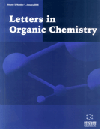- Home
- A-Z Publications
- Letters in Organic Chemistry
- Previous Issues
- Volume 20, Issue 5, 2023
Letters in Organic Chemistry - Volume 20, Issue 5, 2023
Volume 20, Issue 5, 2023
-
-
Direct Vinylation of Activated Methines by a Vinylsulfonium Salt
More LessAuthors: Chunsong Xie, Jiahong Hu, Xiaole Zhu, Song Wu, Yujia Xu and Hongyi YeVinylation of activated methines is a synthetically useful and challenging transformation. Traditional methods for this transformation always encounter multiple steps, limited generality and/or handling gaseous substrates. Herein, we report by using diphenyl(vinyl)sulfonium triflate as a vinylation component, a one-step direct vinylation of activated methines can be realized under mild conditions. This reaction, compatibl Read More
-
-
-
How Medium Affects the Activity and Stereopreference of Thermoanaerobacter ethanolicus Secondary Alcohol Dehydrogenase Catalyzed Reduction of Ketones
More LessAuthors: Ibrahim Karume, Simon Bbumba and Simon TewoldeThe activity and selectivity of W110G Thermoanaerobacter ethanolicus secondary alcohol dehydrogenase were altered by cosubstrate and cosolvent at varying temperatures. A sharp drop in the enantiomeric excess (ee) was observed at 60°C in the first 3 h, suggesting increased selectivity mistakes in the reduction of 4-phenyl-2-butanone to the expected (S)-4-phenyl-2-butanol using 5% v/v of 2-propanol as a cosu Read More
-
-
-
On Water Synthesis of 3-Aryl-5,7-dimethyl-1,2,4-triazolo[4,3-a]pyrimidines using Iodobenzene Diacetate
More LessAuthors: Rinku Soni, Deepak K. Aneja, Monika Sihag, Neha Rani and Mayank KingerA simple and green methodology has been developed for the synthesis of 3-aryl-5,7- dimethyl-1,2,4-triazolo[4,3-a]pyrimidines in water. Oxidative cyclization of 4,6-dimethyl-2- pyrimidinylhydrazones of different aldehydes was achieved in good to excellent yield using iodobenzene diacetate at room temperature. High efficiency, easy work-up, short reaction time, non-toxicity of solvent and ambient temperature are the advanta Read More
-
-
-
Convenient Synthetic Approaches for Novel Impurities of Propisochlor Herbicide
More LessAuthors: Prajna P. Mohanta, Hari Narayan Pati and Ajaya Kumar BeheraA facile and convenient synthesis of two new and one known impurities of Propisochlor, 2-chloro-N-(2-chloroethanoyl)-N-(2-ethyl-6-methylphenyl)-ethanamide, 2,2-dichloro-N-(2- ethyl-6-methyl-phenyl)-N-(isopropxymethyl)-ethanamide and 2-chloro-N-(2-ethyl-6-methylphenyl)- N-methylethanamide have been developed from the readily available 2-ethyl-6-methylaniline precursor. All the synthesized impurities are Read More
-
-
-
Eco-friendly, Fact and Green Synthesis of Methanobenzo[d]naphtho[1,2- g][1,3]Oxazocines using 1-Butyl-3-methylimidazolium Hydroxide under Solvent-free Ball Milling
More LessA green, solvent-free, and efficient strategy for the assembly of methanobenzo[ d]naphtho[1,2-g][1,3]oxazocine heterocycles using 1-butyl-3-methylimidazolium hydroxide ([bmim]OH) ionic liquid under ball-milling solvent-free condition has been developed. For this purpose, the synthesis of methanobenzo[d]naphtho[1,2-g][1,3]oxazocine derivatives was carried out in a single step and one-pot reaction using 2-naphthol and Read More
-
-
-
Alkaline Methanolysis and Octylamine Addition Products of Dehydrocostus Lactone Isolated from Echinops kebericho Root
More LessDehydrocostus lactone is biosynthesized in Saussurea lappa (commonly known as costus), Echinops kebericho, and E. amplexicaulis. Since reports described the compound as a bioactive metabolite, many analogues were synthesized to evaluate the structure-activity relationship. In this study, two new analogues of the active principle were synthesized to compare their mycelial growth inhibition potential against two plant patho Read More
-
-
-
Significance of Molecular Docking in Developing Potent Antimicrobial 1,3,4-Thiadiazole Derivatives
More LessAuthors: Parminder Kaur and Vimal AroraNew drug development has been a convoluted, costly, tedious, and difficult job. Overall, enormous sums of money are required for a new drug development pipeline through traditional methods. The pharmaceutical industry faces challenges in diminishing the research cost and time period for new drug discovery. Artificial intelligence has contributed to the industry for quicker, less expensive, and more successful drug desig Read More
-
-
-
Different Chemosensing Pathways: A Short Review
More LessAuthors: Puspita Sinha, Sunita Prajapati and Subrata JanaThis short review focused on the different sensing mechanisms of the chemo and biosensors, which has been regularly exploited during the research in this field. This review focuses on the basic understanding of the electronic changes of the sensors and their interaction with different analytes.
-
-
-
Acemannan from Aloe vera Extract: A Catalyst-Free, Approach for the Access of Imidazole-Fused Nitrogen-Bridgehead Heterocycles
More LessAuthors: Jyoti Baranwal, Swastika Singh, Smriti Kushwaha and Archana JyotiA series of 2-phenyl substituted imidazo-pyridines, pyrazines and pyrimidines were synthesized through an efficient one-pot, environmentally benign, and regioselective strategy which involves the reaction between 2-bromocarbonyl compounds and 2-aminopyridines, 2-aminopyrazines, 2- aminopyrimidines, respectively using A Aloe vera loe vera/water (3:2) as a green promoting media. To the best of our knowledge, this is Read More
-
-
-
Combined Experimental and Theoretical Spectroscopic Properties (FT-IR, FT-Ra, Uv-Vis, and NMR), DFT Studies, Biological Activity, Molecular Docking, and Toxicity Investigations of 3-methoxy-1-piperazinylbenzene
More LessAuthors: Ceyhun Kucuk, Senay Yurdakul and Belgin ErdemBackground: Piperazine and its derivatives have many important pharmacological properties such as antimicrobial, antituberculosis, anticancer, antiviral, and antimalarial activity, as well as HIV protease inhibitors and antidepressant activity. Therefore, the structural, spectroscopic, electronic, optic, and thermodynamic properties, and biological activity of the 3-methoxy-1- piperazinylbenzene molecule, which is a piperazine der Read More
-
-
-
Prediction of Partition Coefficient of Carbamates using GA-MLR and GAANN Methods, and Comparison with Experimental Data
More LessAuthors: Seyedeh A. Moosavi, Esmat Mohammadinasab and Tahereh Momeni IsfahaniIn the present study, quantum mechanics calculations at the B3LYP theory level and 6- 31G* basis set were carried out to obtain the optimized geometry of carbamates. Then, a comprehensive set of molecular descriptors was computed by using the Dragon software. A genetic algorithm (GA) was also applied to select the suitable variables that resulted in the best-fixed models. The relationship between the molecular desc Read More
-
Volumes & issues
-
Volume 22 (2025)
-
Volume 21 (2024)
-
Volume 20 (2023)
-
Volume 19 (2022)
-
Volume 18 (2021)
-
Volume 17 (2020)
-
Volume 16 (2019)
-
Volume 15 (2018)
-
Volume 14 (2017)
-
Volume 13 (2016)
-
Volume 12 (2015)
-
Volume 11 (2014)
-
Volume 10 (2013)
-
Volume 9 (2012)
-
Volume 8 (2011)
-
Volume 7 (2010)
-
Volume 6 (2009)
-
Volume 5 (2008)
-
Volume 4 (2007)
-
Volume 3 (2006)
-
Volume 2 (2005)
-
Volume 1 (2004)
Most Read This Month
Article
content/journals/loc
Journal
10
5
false
en


